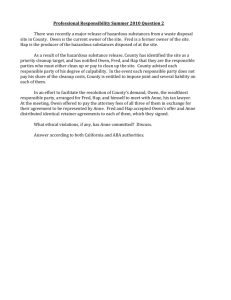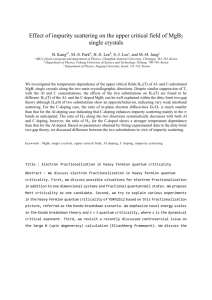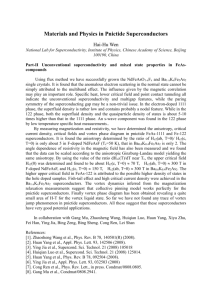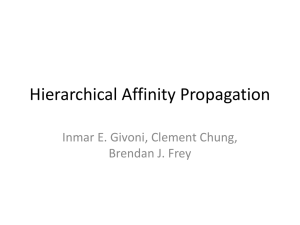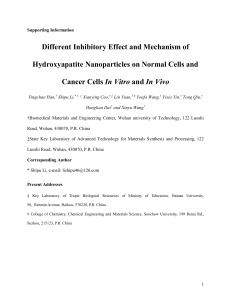untitled - digital-csic Digital CSIC
advertisement
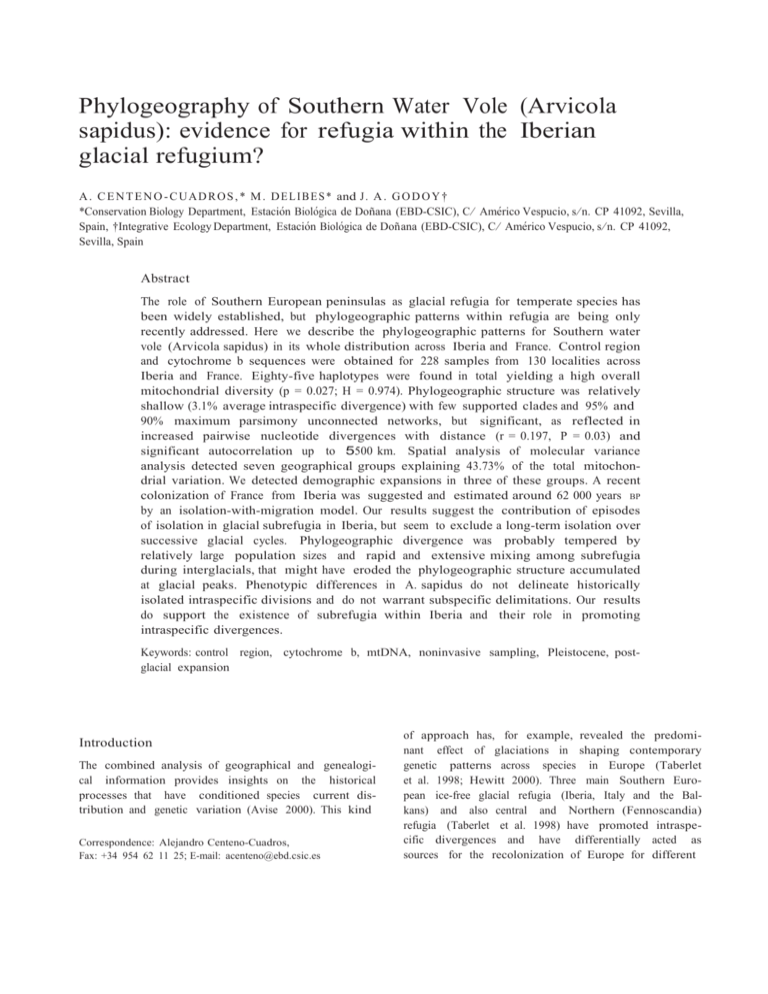
Phylogeography of Southern Water Vole (Arvicola sapidus): evidence for refugia within the Iberian glacial refugium? A . C E N T E N O - C U A D R O S , * M . D E L I B E S * and J . A . G O D O Y † *Conservation Biology Department, Estación Biológica de Doñana (EBD-CSIC), C ⁄ Américo Vespucio, s ⁄ n. CP 41092, Sevilla, Spain, †Integrative Ecology Department, Estación Biológica de Doñ ana (EBD-CSIC), C ⁄ Américo Vespucio, s ⁄ n. CP 41092, Sevilla, Spain Abstract The role of Southern European peninsulas as glacial refugia for temperate species has been widely established, but phylogeographic patterns within refugia are being only recently addressed. Here we describe the phylogeographic patterns for Southern water vole (Arvicola sapidus) in its whole distribution across Iberia and France. Control region and cytochrome b sequences were obtained for 228 samples from 130 localities across Iberia and France. Eighty-five haplotypes were found in total yielding a high overall mitochondrial diversity (p = 0.027; H = 0.974). Phylogeographic structure was relatively shallow (3.1% average intraspecific divergence) with few supported clades and 95% and 90% maximum parsimony unconnected networks, but significant, as reflected in increased pairwise nucleotide divergences with distance (r = 0.197, P = 0.03) and significant autocorrelation up to 5500 km. Spatial analysis of molecular variance analysis detected seven geographical groups explaining 43.73% of the total mitochondrial variation. We detected demographic expansions in three of these groups. A recent colonization of France from Iberia was suggested and estimated around 62 000 years BP by an isolation-with-migration model. Our results suggest the contribution of episodes of isolation in glacial subrefugia in Iberia, but seem to exclude a long-term isolation over successive glacial cycles. Phylogeographic divergence was probably tempered by relatively large population sizes and rapid and extensive mixing among subrefugia during interglacials, that might have eroded the phylogeographic structure accumulated at glacial peaks. Phenotypic differences in A. sapidus do not delineate historically isolated intraspecific divisions and do not warrant subspecific delimitations. Our results do support the existence of subrefugia within Iberia and their role in promoting intraspecific divergences. Keywords: control region, cytochrome b, mtDNA, noninvasive sampling, Pleistocene, postglacial expansion Introduction The combined analysis of geographical and genealogical information provides insights on the historical processes that have conditioned species current distribution and genetic variation (Avise 2000). This kind Correspondence: Alejandro Centeno-Cuadros, Fax: +34 954 62 11 25; E-mail: acenteno@ebd.csic.es of approach has, for example, revealed the predominant effect of glaciations in shaping contemporary genetic patterns across species in Europe (Taberlet et al. 1998; Hewitt 2000). Three main Southern European ice-free glacial refugia (Iberia, Italy and the Balkans) and also central and Northern (Fennoscandia) refugia (Taberlet et al. 1998) have promoted intraspecific divergences and have differentially acted as sources for the recolonization of Europe for different species. For some species, the Pyrenees and the Alps seem to have acted as effective barriers to the recolonization from Iberian and Italian peninsulas, respectively. Most studies, being focused on the divergence among refugia have, however, paid little attention to the distribution of genetic variation within refugia, assuming it to be homogeneous. However, recent studies suggest that glacial refugia are heterogeneous mosaics of climatic and ecological regions that have shaped complex phylogeographic patterns. Furthermore, concordant distributions of divergent intraspecific lineages across taxa have led to the proposition of the ‘refugia-within-refugia’ concept (Gó mez & Lunt 2007; Weiss & Ferrand 2007). At the species level, these subrefugia usually harbour significantly differentiated intraspecific lineages, thus making an important contribution to overall species diversity. At a broader scale, glacial refugia become hotspots of biodiversity and sources of endemism, as new taxa are originated within a relative reduced region. The Iberian Peninsula harbours a high physiographic complexity (East-Western oriented mountainous chains) that, in combination with concurrent Mediterranean and Atlantic influences, results in an appropriate area for the study of the ‘refugia-within-refugia’ concept. Most recent studies on Iberian phylogeography have involved amphibians (Martinez-Solano et al. 2006; Sequeira et al. 2008) and reptiles (Pinho et al. 2007; Godinho et al. 2008) [see Gó mez & Lunt (2007), for examples in other organisms]. These taxa are usually characterized by low dispersal capacities what have favoured the long-term isolation of their populations through successive glacial cycles (Plio-Pleistocene) and the consequent evolution of deep divergences within Iberia. In contrast, the effect of glacial subrefugia on organisms with more complex population dynamics and higher dispersal capacities have been seldom addressed (e.g. Vilà et al. 1999). These studies might not only help to evaluate the relative importance of these areas for the conservation of biodiversity, but might also significantly add to our understanding of the complex interactions between life-history traits, demographic history and genealogical patterns. Rodents are good phylogeographic models because they often provide an abundant fossil register, inspiring hypotheses on their evolutionary history and adaptative evolution. These hypotheses can now be tested with molecular data (Tougard & Renvoise 2008). The genus Arvicola includes two species of water voles in Eurasia. Arvicola terrestris is the most widespread species, extending from the North of the Iberian Peninsula to the East of Asia, while the Southern water vole (Arvicola sapidus) is restricted to the Iberian Peninsula and France. The origin of the latter species has been located in Iberia during the Pleistocene using fossil records (Sesé Benito 1994). Phylogenetic analysis showed these two species to be reciprocally monophyletic and dated their divergence during the Middle Pleistocene (Taberlet et al. 1998; Wust Saucy 1998; Wust Saucy et al. 1998). Phylogeographic (Wust et al. 1998; Piertney et al. 2005) and population genetic studies using neutral (Stewart et al. 1999; Telfer et al. 2003; Berthier et al. 2005, 2006; Aars et al. 2006) and nonneutral markers (Oliver & Piertney 2006; Bryja et al. 2007; de Bellocq et al. 2008; Tollenaere et al. 2008; Oliver et al. 2009) have contributed to the understanding of historical and current factors promoting genetic structure of A. terrestris. Three less divergent genetic lineages have been found within A. terrestris, corresponding to Italian, Balkan and Fennoscandian refugia (Taberlet et al. 1998). In contrast, genetic studies with A. sapidus have only covered cytogenetics and chromosomal characterization (Diaz de la Guardia & Pretel 1978; Megı́as-Nogales et al. 2003) and phylogeographic analysis of A. sapidus are lacking. Shallow phylogeographic structure for A. sapidus is expected if a single large population survived in Iberia and did not undergo any fragmentation during glacial maxima. However, morphological differences among populations of A. sapidus suggest local adaptation or genetic structure and belie a simple model of a single population in a single Iberian refugium. Two main morphological differences have been reported: (i) a reduction of 20–25% in body size and weight of individuals from a Southwest population (Natural region of Doñ ana) (Romá n 2007) and (ii) differences in coat colour which have prompted a controversial subspecific division into A. sapidus tenebricus (darker, in the North of Iberia) and A. sapidus sapidus (brown coloured coat, widespread over Iberia and France) (Ventura 2002). In this study, we analyse the geographical distribution of mitochondrial genetic variation in Southern water voles. We relied mostly on bones sampled in raptor pellets, which proved adequate sources for the characterization of two short but polymorphic mitochondrial markers (control region and cytochrome b), but poor materials for additional nuclear DNA analyses. Mitochondrial DNA patterns have nevertheless been shown to be robust indicators of patterns of population history, and the markers most suited for the analyses of recently isolated populations (Zink & Barrowclough 2008). We test whether an intraspecific mitochondrial structure exists and whether it is consistent with historical isolation in subrefugia within the Iberian Peninsula and evaluate its concordance with morphological and coat colour differences. We also dated major events like the colonization of France from Iberia. Materials and methods Sampling and DNA extraction Samples from 299 Southern water voles covering the whole distribution area of the species and from 12 Arvicola terrestris (from the North region of Iberia), which are included here as outgroup, were obtained mostly as donations from biologists and scientific collections. These samples consist mainly of bones (jaws, molars or incisors) obtained from owl and eagle owl pellets and fixed tissues from museums, although fresh tissues were used when available. All bones collected were morphologically identified as Arvicola sapidus by the authors (Dueñ as & Peris Álvarez 1985). Multiple sampling of the same individual is highly unlikely since only a single tooth or mandible was used per pellet and individual water voles are always predated by a single owl. Because of the variability in amplification success between individuals and fragments, 273 individuals were included in the data set for D-Loop genetic variation, whereas 254 individuals were used for cytochrome b analysis. For phylogeographic analyses, we considered only those 228 individuals for which both fragments were sequenced. These individuals were sampled at 130 different localities distributed among 38 counties throughout Iberia and France (Table 1). Bones were frozen under liquid nitrogen and homogenized to powder with a ball-mill (RETSCH Mod. MM301). DNA was extracted using a guanidiniumsilica protocol [method C in Rohland & Hofreiter (2007)]. Museum pelts were extracted with a standard phenol–chlorophorm protocol, following extensive washes in TE9 (500 mM Tris pH 9, 20 mM EDTA, 10 mM NaCl, pH 9) (Goetz et al. 1985) to remove inhibiting salts (Shiozawa et al. 1992). Both types of material were extracted following ancient DNA guidelines in a dedicated laboratory. Contamination with modern DNA or PCR products was monitored by including two extraction blanks in every extraction round. Finally, DNA from fresh tissues was extracted with a ‘salting-out’ protocol (Mü llenbach et al. 1989) including two successive LiCl precipitation and chloroform extractions for protein removal. Mitochondrial DNA sequencing D-Loop and cytochrome b markers were sequenced in this study. As endogenous DNA available in most samples was limited and degraded, we used forward F15468 (5¢-GCATTAAATTATATTCCCCATGC-3¢) and reverse R15713 (5¢-TTGTTGGTTTCACGGAGGAT-3¢) (D-Loop) and forward F14559 (5¢-TCCTTTTGAGGGGC TACAGT-3¢) and reverse R14806 (5¢-TGGAAGGGAATTTTGTCTGC-3¢) (cytochrome b) primers (Centeno-Cuadros and Godoy, unpublished data) to amplify short and maximally informative fragments. Polymerase chain reaction (PCR) was performed in a final volume of 25 lL and consisted of 5 lL of extract, 2 mM MgCl2, 0.25 mM dNTPs, 0.25 mM forward and reverse sequence-specific primers, 1· Taq polymerase buffer and 1 U ⁄ mL Taq (BIOTAQTM DNA Polymerase; Bioline). Bovine Serum Albumine (BSA; Roche), 0.8 and 0.1 mg ⁄ mL, was added to prevent inhibition in bonesmuseum and fresh tissue samples, respectively. PCRs were performed in a MJ research PT200 thermocycler programmed for an initial denaturation at 94 °C for 5 min, followed by 40 cycles of denaturation at 92 °C for 30 s, annealing at 52 °C for 30 s and extension at 72 °C for 30 s. All reactions were finished with a final extension at 72 °C for 5 min. To control the performance of the process and monitor for contamination, positive (DNA obtained from fresh tissue) and negative (water) DNA controls, respectively, were included with each set of PCR reactions. Five microlitres of PCR products was incubated with 2 lL ExoSAP-IT enzyme (Exonuclease I and Shrimp Alkaline Phosphatase in buffer) (USB Corporation) for 15 min at 37 °C and inactivated for 15 min at 80 °C. Fragments were bidirectionally sequenced using the Applied Biosystems BigDye® Terminator Cycle Sequencing Kit v. 1.1 following manufacturer’s instructions and the same primers used for the amplification. Reactions were analysed in an Applied Biosystems 3130 · l Genetic Analyzer. Forward and reverse sequences for each PCR product were edited and assembled using Sequencher 4.6 (Gene Codes Corporation). Genetic data analyses Genetic diversity. Nucleotide and haplotype diversities were estimated for control region and cytochrome b fragments separately (see Sampling and DNA extraction) and analysed with DnaSP 4.50.3 (Rozas et al. 2003). Since both fragments belong to the same DNA molecule, all subsequent analyses were performed with both sequences per individual concatenated in two partitions: control region from nucleotide position 1–205 and cytochrome b from nucleotide position 206–413. As a first approach to detect a signal for northward range expansion, we tested the existence of a gradient in nucleotide diversity over geographical localities, a pattern that might arise from a series of founding events in a leading-edge colonization process (Ibrahim et al. 1996). We estimated nucleotide diversity in geographical localities with more than five sampled individuals and compared average nucleotide diversities in Table 1 Geographical and sample type distribution of the samples used in this study Map. Ref. Spain 1 2 3 4 5 6 7 8 9 10 11 12 13 14 15 16 17 18 19 20 21 22 23 24 25 France 26 27 28 29 30 31 32 33 Portugal 34 35 36 37 38 County Localities Sample size Sample type Latitude Longitude Á vila Barcelona Badajoz Burgos Cá diz Cá ceres Castelló n Gerona Granada Guadalajara Huelva Jaén Lérida La Rioja Lugo Navarra Pontevedra Santander Sevilla Soria Tarragona Teruel Valladolid Zaragoza Zamora 2 2 1 9 1 2 4 2 1 1 15 1 1 3 1 4 4 2 2 2 14 3 3 6 1 2 2 2 9 1 2 8 3 1 2 15 1 1 3 1 7 9 2 2 2 19 3 5 7 1 1, (1) [2] 2 6, (1), [2] (1) 2 (8) 2, [1] 1 2 5, (10) 1 [1] 3 1 7 9 2 1, (1) 2 18, [1] 3 5 7 1 40.4271 41.2985 38.8666 42.1729 36.0616 40.1057 40.7544 41.8490 36.9728 41.2064 36.9876 37.9108 41.8950 42.3269 42.5903 42.7539 42.7961 42.9892 37.9337 41.6100 41.2312 40.8541 41.5580 41.6071 41.8509 )5.3032 1.9937 )6.4274 )3.7077 )5.6363 )5.7217 )0.1635 2.3902 )3.4531 )2.6023 )6.4814 )3.0024 1.0475 )3.0377 )7.1923 )1.0998 )8.1686 )3.9710 )5.7621 )3.4016 0.7172 )1.0960 )5.0043 )0.7568 )5.6129 Alpes Maritimes Auvergne Drô me Creuse Corrè ze Haute-Vienne Vendé e Pyré né es-Orientales 1 14 1 1 2 1 1 3 1 14 2 5 17 9 1 5 (1) (14) 1, 1* 5 17 8, 1* 1 5 43.7738 45.7344 44.6658 45.8736 45.2635 45.8053 46.9674 42.8332 6.7857 2.6273 5.7063 1.6440 1.6775 0.9337 )2.2635 2.9191 Beja Évora Faro Setú bal Vila Real 1 3 1 13 1 4 12 4 42 2 4 12 4 (42) 2 38.2041 38.7047 37.4394 37.9383 41.2826 )7.2327 )7.4000 )7.7670 )8.7766 )7.9041 A total of 228 samples were collected from 130 geographical localities. The number of samples corresponding to fresh tissue, museum and hair samples is marked between parentheses, square brackets or with an asterisk respectively. The remaining samples are bones obtained from owl-pellets Iberia and France by using the Welch approximate t-test to account for the possible difference in variance among samples. Phylogeny. Control region and cytochrome b sequences were aligned using ClustalW (Thompson et al. 1994) as implemented in MEGA4 (Tamura et al. 2007). The optimal nucleotide substitutions model was selected among 56 models tested for control region [K81uf+I+G, with unequal base frequencies (uf), the proportion of invariable sites (I) equalling 0.29 and gamma (a) distribution shape parameter (G) of 0.36], cytochrome b (HKY+G, a = 0.33) and both sequences concatenated (K81uf, I = 0.56, G = 0.45), based on the Akaike Information Criterion (AIC) (Posada & Buckley 2004) as implemented in ModelTest (Posada & Crandall 1998). We employed a Bayesian phylogenetic inference approach using a variant of Markov Chain Monte Carlo implemented in MrBayes 3.1.2 (Huelsenbeck & Ronquist 2001), with three favoured partitions (control region: nucleotide positions 1–205; cytochrome b: nucleotide positions 206–413; encoded gaps: sequence positions 414–416) and allowing for differences in evolutionary models and mutation rates (control region: nst = 6, rates = gamma; cytochrome b: nst = 2, rates = gamma). Gaps were considered as a fifth state and coded with GAPCODER (Young & Healy 2003). Three independent runs with 10 chains were performed simultaneously, using a heating scheme (temp = 0.30). The length of the run was automatically adjusted to that required to reduce the standard deviation of split frequencies below 0.005 (stopval = 0.005). Consensus trees with average branch lengths and parameter estimates were obtained from the samples remaining after discarding the first 25% of saved states as burnin. Phylogeography. Maximum parsimony network construction methods establish a statistical criterion (statistical parsimony) by which every haplotype that do not exceed a parsimony limit is joined into a single network, leaving as unconnected networks those haplotypes that differ by more than the statistically determined threshold. We favoured this statistical procedure that divided the overall inferred genetic diversity into significantly different units vs. algorithms which tend to join into a single network every haplotype independently of the amount of nucleotide differences among them. For this purpose, we used the software TCS v.1.21 (Clement et al. 2000) and both 90% and 95% parsimony connection limits (MP90 and MP95 respectively). Thus, while unconnected MP95 networks are usually interpreted as intraspecific genetic lineages resulting from long-term isolation by barriers [allopatric fragmentation (Templeton 2004)], we used differences in connection limits between MP90 and MP95 networks to test the strength of this genetic structure, hypothesizing that patterns which result from long-term isolation and are strongly differentiated must not be importantly affected by slight changes in parsimony limits. Patterns of isolation by distance in the data were explored using two complementary approaches. Arlequin 3.0 (Excoffier et al. 2005) was used to compute a Kimura 2-parameter corrected pairwise nucleotide distance matrix among haplotypes and its correlation with a geographical distance matrix was evaluated with Mantel tests. On the other hand, we performed an autocorrelation analysis using II, an autocorrelation index for DNA analysis (AIDA) analogous to Moran’s I, which incorporates the nucleotide distances among sequences (Bertorelle & Barbujani 1995). Class boundaries to geographical distances were chosen according to an equal frequencies criterion, i.e. number of pairwise distances was divided into classes in order to obtain an equal number of comparisons in each class. A subset of 200 randomly chosen individuals was selected to perform this analysis because of computational limitations. Genetic structure. We further explored global genetic structure in the species using Spatial Analysis of Molecular Variance (SAMOVA) (Dupanloup et al. 2002). This method defines k continuously homogenous but genetically differentiated populations where the proportion of total genetic variance (FCT) is maximized. Since FCT increases as k increases we run SAMOVA with 1000 simulated annealing processes for a range of k values from 2 to 10. For this and other analyses based on allele frequencies, we made geographical groupings of samples based on counties, and excluded those with less than five samples. We estimated pairwise FST among counties using Kimura 2-parameters genetic distance, as implemented in Arlequin 3.0 and tested its correlation with the log of geographical distance with Mantel tests after linearization of FST [FST ⁄ (1 ) FST)] as recommended by Rousset (1997). We also tested the role of Pyrenees as a barrier to population postglacial expansion of water voles once discounting the effects of Euclidean distance through Partial Mantel test, using a binary matrix of pairs of spatial points separated by the Pyrenees (1) or not (0). Demography. Historical demography was analysed on those partitions suggested by SAMOVA. Tajima’s (1989) D measures deviations from the correlation between the number of segregating sites and the average number of nucleotide differences expected under a model of neutral evolution; it was estimated with DnaSP 4.50.3 (Rozas et al. 2003). As Tajima’s D may be affected by other demographic and evolutionary processes and depends on factors as sample size, length of sequence and time of sampling relative to a demographic event and its strength (Simonsen et al. 1995; Depaulis et al. 2003; Pannell 2003), we also tested for historical population expansion with mismatch distribution analysis (Marjoram & Donnelly 1994). A multimodal distribution of pairwise differences is expected from a stationary population whereas an unimodal distribution would be shown if the population have experienced a demographic expansion (Rogers & Harpending 1992). We compared the observed frequency distribution of pairwise nucleotide differences with their expected distribution in a simulated population expansion using DnaSP 4.50.3. Moreover, we estimated raggedness indexes to measure the smoothness of mismatch distribution. Therefore, nonsignificant deviations of expected and observed mismatch distributions and nonsignificant or significant but low values of raggedness indexes would indicate a past population expansion. The Rogers & Harpending (1992) model was used to calculate the time since population expansion by estimating Tau (s) based on the mismatch distribution outputs from Arlequin 3.0. We converted the parameter s to estimate the time since the expansion (t) using the equation t = s ⁄ 2u, where u is the mutation rate per sequence per generation. We used per site substitution rates previously reported for rodents cytochrome b (4%) and control region (46%) (Fink et al. 2004; Hamilton et al. 2005), and a generation time of 6 months, what results in a mutation rate per generation for the concatenated sequence of u = 5.13 · 10)5 (Rogers 1995; Schneider & Excoffier 1999). The time of colonization of France from Iberia was estimated by fitting an Isolation with Migration model to our genetic data, as implemented in IMA (updated version 21 ⁄ 4 ⁄ 2008) (Hey & Nielsen 2007). Three independent runs of 20 chains and a geometric heating scheme were used to explore the posterior probability space. Ten millions genealogies were sampled of which the first 10% were discarded as burn-in (Mmode), which were then used to assess the joint parameter estimate (Lmode) using the same exploratory parameters. Run parameters and priors were adjusted until stationarity and convergence were reached, as assessed by the autocorrelation of the parameters among independent points (<0.01), large effective sample sizes (ESS > 100), and high update rates (>2%). Lower updates rates might be acceptable when the other criteria are met and independent runs yield concordant estimates (J. Hey, personal communication). Estimates of model parameters were scaled to demographic and year units by considering substitution rates per site per million years of 4% and 46% for cytochrome b and control region respectively (Fink et al. 2004; Hamilton et al. 2005). Results Genetic diversity A total of 254 and 273 samples were sequenced for cytochrome b and control region respectively. Of these, 158 and 140 were obtained from bones collected in owlpellets (respectively), which showed a high rate of amplification success for the targeted mitochondrial fragments (cytochrome b: 92%; control region: 84%). Reported sequences obtained from this material did not show ambiguities in direct sequencing (control region nor cytochrome b), did not contain any nonsense or frameshift mutations nor showed an excess of nonsynonymous mutations (cytochrome b), and were not too divergent to sequences obtained from fresh material, suggesting that they were not severely affected by miscoding lesions or that they did not originate from the amplification of nuclear insertions of mitochondrial fragments. Variation in control region sequences was high, with 69 variable sites that defined a total of 77 haplotypes [p (SD) = 0.046 (0.001); H (SD) = 0.963 (0.004)]. Most variation was due to transitions (92.8%), with only 7.18% transversions and one indel. Cytochrome b sequences included 24 variable sites (91.3% transitions and 8.7% transversions) which defined 24 haplotypes in Arvicola sapidus [p (SD) = 0.008 (0.001); H (SD) = 0.718 (0.001)]. Parsimony informative sites were found in 17 out of the total amount of variable sites. Most substitutions were synonymous, with only two nonsynonymous mutations resulting in conservative aminoacidic changes from alanine to glycine and valine to isoleucine occurring at nucleotide positions 21 and 74, respectively. Finally, the 228 concatenated sequences defined 85 A. sapidus haplotypes [p (SD) = 0.027 (0.011); H (SD) = 0.974 (0.003)], which were used for phylogenetic and phylogeographic analyses (Table 2), together with the six Arvicola terrestris haplotypes found in the 12 individuals analysed. As expected, nucleotide diversities were higher for localities where two divergent lineages concur (see below). French localities showed significantly lower nucleotide diversity than Iberian localities, once the admixed population in Pyré né es Orientales is excluded (Welch’s approximate t-test: t¢ = 2.047; P = 0.032), suggesting a recent colonization of France from a reduced number of founders. Phylogeny The inferred Bayesian phylogenetic tree confirmed the previously reported reciprocal monophyly and deep divergence between A. terrestris and A. sapidus (average net divergence, 10.1%) (Fig. 1). On the contrary, only a shallow phylogenetic structure was detected among A. sapidus haplotypes, as reflected in few statistically supported nodes (‡95% Bayesian posterior probability) and relatively short internal branches (average intraspecific distances: 3.1%). Supported clades were geographically restricted ⁄ coherent, with the exception of haplotypes in three clades sampled in distant areas (marked with an asterisk in Fig. 1). Haplotypes in clade 1 were mostly sampled in SW Iberia but a few clade 1 haplotypes were sampled in Northern regions (Ávila, Burgos and Zaragoza, see codes in Table 1 and their geographical position in Fig. 3). Clade 2 included all haplotypes Table 2 GenBank Accession numbers to control region and cytochrome b sequences that composed the 85 concatenated haplotypes of Arvicola sapidus used in this study Haplotype N Hap_1 Hap_2 Hap_3 7 1 9 Hap_4 Hap_5 Hap_6 Hap_7 Hap_8 3 2 2 1 4 Hap_9 Hap_10 Hap_11 Hap_12 Hap_13 Hap_14 Hap_15 4 3 1 1 1 1 4 Hap_16 Hap_17 Hap_18 Hap_19 Hap_20 Hap_21 Hap_22 Hap_23 Hap_24 Hap_25 Hap_26 Hap_27 2 1 1 1 1 1 1 2 1 1 1 14 Hap_28 Hap_29 Hap_30 Hap_31 1 1 3 13 Hap_32 Hap_33 Hap_34 Hap_35 Hap_36 Hap_37 Hap_38 Hap_39 Hap_40 Hap_41 Hap_42 Hap_43 1 1 1 1 1 1 1 1 2 1 1 3 Geog. Loc. (n) CR GenBank no. Cytb GenBank no. Haplotype Geog. Loc. (n) CR GenBank no. Cytb GenBank no. 7 (7) 7 (1) 11 (4), 30 (1), 37 (4) 11 (3) 11 (1), 35 (1) 11 (2) 5 (1) 19 (1), 36 (1), 37 (2) 1 (1), 11 (3) 10 (1), 23 (2) 3 (1) 3 (1) 20 (1) 20 (1) 1 (1), 14 (1), 22 (1), 25 (1) 6 (2) 18 (1) 11 (1) 11 (1) 14 (1) 4 (1) 4 (1) 4 (2) 4 (1) 4 (1) 10 (1) 2 (1), 8 (1), 13 (1), 16 (5), 21 (6) 16 (1) 16 (1) 35 (3) 22 (1), 24 (1), 34 (2), 35 (7), 36 (2) 34 (1) 34 (1) 35 (1) 36 (1) 24 (1) 22 (1) 24 (1) 24 (1) 17 (2) 17 (1) 17 (1) 17 (3) FJ895493 FJ895494 FJ895495 FJ895408 FJ895409 FJ895410 Hap_44 Hap_45 Hap_46 1 1 1 17 (1) 17 (1) 15 (1) FJ895536 FJ895537 FJ895538 FJ895451 FJ895452 FJ895453 FJ895496 FJ895497 FJ895498 FJ895499 FJ895500 FJ895411 FJ895412 FJ895413 FJ895414 FJ895415 Hap_47 Hap_48 Hap_49 Hap_50 Hap_51 1 2 8 4 5 19 30 27 30 18 (1) (2) (1), 29 (1), 30 (6) (4) (1), 30 (3), 31 (1) FJ895539 FJ895540 FJ895541 FJ895542 FJ895543 FJ895454 FJ895455 FJ895456 FJ895457 FJ895458 FJ895501 FJ895502 FJ895503 FJ895504 FJ895505 FJ895506 FJ895507 FJ895416 FJ895417 FJ895418 FJ895419 FJ895420 FJ895421 FJ895422 Hap_52 Hap_53 Hap_54 Hap_55 Hap_56 Hap_57 Hap_58 7 1 1 1 3 1 1 31 31 30 29 29 32 26 (7) (1) (1) (1) (3) (1) (1) FJ895544 FJ895545 FJ895546 FJ895547 FJ895548 FJ895549 FJ895550 FJ895459 FJ895460 FJ895461 FJ895462 FJ895463 FJ895464 FJ895465 FJ895508 FJ895509 FJ895510 FJ895511 FJ895512 FJ895513 FJ895514 FJ895515 FJ895516 FJ895517 FJ895518 FJ895519 FJ895423 FJ895424 FJ895425 FJ895426 FJ895427 FJ895428 FJ895429 FJ895430 FJ895431 FJ895432 FJ895433 FJ895434 Hap_59 Hap_60 Hap_61 Hap_62 Hap_63 Hap_64 Hap_65 Hap_66 Hap_67 Hap_68 Hap_69 Hap_70 2 1 1 1 1 1 1 1 1 1 5 1 28 12 21 4 4 2 38 38 14 8 8 21 (2) (1) (1) (1) (1) (1) (1) (1) (1) (1) (1), 21 (1), 33 (3) (1) FJ895551 FJ895552 FJ895553 FJ895554 FJ895555 FJ895556 FJ895557 FJ895558 FJ895559 FJ895560 FJ895561 FJ895562 FJ895466 FJ895467 FJ895468 FJ895469 FJ895470 FJ895471 FJ895472 FJ895473 FJ895474 FJ895475 FJ895476 FJ895477 FJ895520 FJ895521 FJ895522 FJ895523 FJ895435 FJ895436 FJ895437 FJ895438 Hap_71 Hap_72 Hap_73 Hap_74 2 3 16 17 33 24 37 37 (2) (3) (16) (17) FJ895563 FJ895564 FJ895565 FJ895566 FJ895478 FJ895479 FJ895480 FJ895481 FJ895524 FJ895525 FJ895526 FJ895527 FJ895528 FJ895529 FJ895530 FJ895531 FJ895532 FJ895533 FJ895534 FJ895535 FJ895439 FJ895440 FJ895441 FJ895442 FJ895443 FJ895444 FJ895445 FJ895446 FJ895447 FJ895448 FJ895449 FJ895450 Hap_75 Hap_76 Hap_77 Hap_78 Hap_79 Hap_80 Hap_81 Hap_82 Hap_83 Hap_84 Hap_85 1 5 5 1 1 1 10 2 3 1 1 37 27 27 27 27 27 21 37 23 9 4 (1) (5) (5) (1) (1) (1) (10) (2) (3) (1) (1) FJ895567 FJ895568 FJ895569 FJ895570 FJ895571 FJ895572 FJ895573 FJ895574 FJ895575 FJ895576 FJ895577 FJ895482 FJ895483 FJ895484 FJ895485 FJ895486 FJ895487 FJ895488 FJ895489 FJ895490 FJ895491 FJ895492 N N, total sampling frequency of haplotypes. Geographical localities codes are specified in Table 1. Numbers between parentheses (n) denote the relative sampling frequency per haplotype per geographical location. Fig. 1 Bayesian phylogenetic tree of Arvicola mitochondrial haplotypes (CR + cytb). Specified branch numbers refers to Bayesian posterior probability. Numbers on the right specify statistically supported clades (i.e. ‡95). Letters between parentheses refer to unnconected networks obtained with a 95% maximum parsimony limit. Haplotypes marked with and asterisk (*) were sampled at relatively distant localities. found only in France, and also two samples from Santander and Burgos (Northern Iberia). Clade 3 was geographically restricted to the Northeastern quadrant of the Iberian Peninsula (Tarragona and Barcelona). Clade 4 extends over Northwest quadrant of Iberia. Haplotypes from clade 5 were located in NW Spain (Ponteve- dra) and central Portugal (É vora). Clade 6 was mainly centred over SW Iberia but includes haplotypes located in Northeastern Iberia (Zaragoza and Teruel). Haplotypes sampled on both Spanish and French sides of the Pyrenees (Gerona, Tarragona and Pyré né esOrientales) composed clade 7. groups than among populations within groups (43.7% and 12.8% respectively), compared to a moderate fraction (43.5%) attributed to differences within populations (fixation indexes: FSC = 0.22812, FST = 0.56565, FCT = 0.43729; all P-values < 0.001). Demography Phylogeography Maximum Parsimony networks obtained under a 95% or a 90% parsimony limit were different (Fig. 2). The data set was divided into seven unconnected networks (networks A–G, Fig. 2) when using a 95% parsimony limit (connection limit at six mutational steps), while networks A–E were joined in a single network under a 90% parsimony limit (connection limit at ten steps). Networks B, C, E and G coincided with clades 5, 6, 4 and 7 (respectively) in the Bayesian phylogenetic tree. The geographical distribution of these seven different lineages is drawn in Fig. 3. A high proportion of the overall haplotype diversity of A. sapidus is included in the lineage A, the most frequent and widespread over Iberia and France, and this is surrounded by peripheral, more geographically restricted and partially overlapping lineages (B–G). The only D and F haplotypes were sampled in Northern and Eastern Spain (Santander and Castelló n) respectively. The unconnected lineage G was sampled in the French and Spanish sides of Western Pyrenees. All other French haplotypes derive from haplotype 48 (Corrè ze), and this is connected to haplotype 27, located at the Iberian side of the Pyrenees, by four mutational steps. Despite these few geographical inconsistencies, a global phylogeographic pattern was indicated by the existence of a positive global correlation between pairwise nucleotide differences and Euclidean geographical distance between sampled haplotypes (r = 0.197, P = 0.03), and by the autocorrelogram of II indexes (AIDAs) showing a significant autocorrelation between sequences up to 450–518 km. The Pyrenees did not significantly contributed to the observed genetic structure once the effects of Euclidean distances were discounted (Partial Mantel Test: r = 0.2098, P = 0.1097). Genetic structure The hierarchical and spatial analysis of genetic structure (SAMOVA) suggested a spatial subdivision of the whole distribution area into seven groups (Fig. 3 and Table 3), since FCT values approached a plateau for k = 7. The Analysis of Molecular Variance (AMOVA) with these seven groups revealed a more than three times higher significant percentage of genetic variance among The evidence for historical demographic changes was analysed for each of the partitions suggested by SAMOVA through neutrality tests, goodness of fit to a simulated population expansion, and raggedness index (Table 3) and mismatch distributions (Fig. 4). Although only groups I and II showed significant deviations from neutral expectations [Tajima’s D )1.5894 (P < 0.05) and )1.77 (P < 0.01) respectively], for groups I, III and VI, a signal for demographic expansion was supported by nonsignificant raggedness indexes and mismatch distributions not deviating significantly from that expected under a sudden expansion model. Tau (s) estimates for these partitions (group I: 2.4805; group III: 11.3262; group VI: 4.1055) dated population expansion for group III over 110 000 years BP, followed by population expansions in groups VI and I around 40 000 and 24 000 years BP respectively. Parameters estimated under the Isolation with Migration model for French and Iberian Southern water voles were largely coincident in three independent runs (Table 4), so estimates obtained in the run with the largest ESS for split time are reported below. Estimates of effective population size of the Iberian group (Point estimate: 496 607; HPD 90% interval: 310 281–801 361) were larger than for the French group (106 585; HPD 90% interval: 58 687–182 905), whereas ancestral population size was estimated in 41 844 (HPD 90% interval: 790–166 588). Time since splitting of both groups was estimated in 61 942 years BP. (HPD 90% interval: 34 452–100 499). Interestingly, the date of split approximately coincides with the date of the demographic expansion of the SAMOVA partition VI, estimated in c. 40 000 years BP, which suggests that demographic expansion quickly followed France colonization. Average migration rate from Iberia into France was estimated in 0.0016 gene copies per generation (HPD 90% interval: 0.001–0.0025), while for the reciprocal migration the posterior probability of the migration parameter peaked at the lowest interval indicating it to be close to zero. Notwithstanding, the occurrence of some gene flow from France to Iberia is indicated by the two observations of French haplotypes in Northern Iberia (haplotype 3 in Corrè ze – France and Huelva –Spain- and haplotype 69 in Pyré né es Orientales – France- and Gerona and Tarragona – Spain-). 27 3 74 73 28 33 36 7 14 81 48 16 78 49 8 62 11 84 59 6 29 60 56 58 12 4 30 64 10 38 77 15 9 24 51 54 47 19 72 37 63 57 34 25 80 22 2 21 71 43 26 39 52 79 70 85 50 61 5 A 55 67 76 32 20 53 31 23 42 B C 40 F 35 82 44 1 68 69 17 G D 13 66 83 E 45 46 75 41 65 Fig. 2 Ninety per cent maximum parsimony networks obtained for the 85 haplotypes (numbers) sampled in Arvicola sapidus. Circle sizes are proportional to haplotype frequencies. Capital letters indicate the seven unconnected clades obtained with a 95% parsimony limit. Transversal short lines are mutational steps between haplotypes. Filled squares are unsampled haplotypes. VI 32 27 28 31 28 18 15 17 38 III 14 23 10 13 20 37 3 VII 36 11 19 5 8 24 22 6 34 26 33 V 2 IV 1 35 16 4 25 29 30 I II 21 7 12 A B C D E F G 9 Fig. 3 Geographical distribution of the seven unconnected networks (A–G, see legend) obtained under a 95% maximum parsimony criterion. Bold lines delimit the seven groups obtained with SAMOVA (latin numbers). Numbers indicate locality codes as listed in Table 1. Shaded area denotes the distribution area of the species (IUCN, 2008). Table 3 Genetic diversity and demographic statistics for SAMOVA partitions (I–VII) Statistics I II III IV V VI VII N S p h H k Tajima’s D SSD Raggedness s 95 59 0.014 26 0.905 5.766 )1.5894 0.0218 0.0402 2.4805 8 12 0.007 2 0.25 3.0 )1.7700 0.0891 0.6875 n.e. 19 35 0.025 13 0.953 10.310 0.1183 0.0191 0.0315 11.3262 27 41 0.023 20 0.969 9.601 )0.3660 0.0113 0.0136 n.e. 8 23 0.025 4 0.75 10.536 0.9842 0.2170 0.3304 n.e. 51 32 0.011 19 0.929 4.7 )1.0799 0.0052 0.0192 4.1055 20 30 0.023 8 0.695 9.816 0.6303 0.1048 0.1676 n.e. N, sample size; S, number of segregating sites; p, nucleotide diversity; h, number of haplotypes; H, haplotype diversity; k, mean number of nucleotide differences; SSD, sum of square deviation (goodness-of-fit to a simulated population expansion); n.e., not estimated (see text). s (tau) values for the estimates of time since population expansion was estimated based on mismatch distribution (see text). Tajima’s D, SSD and Raggedness index values in bold show significant tests (P < 0.05). Discussion Evolutionary history of Arvicola sapidus Taberlet et al. (1998) summarized the phylogeny of Arvicola spp. as a genus with four lineages, the most basal one corresponding to Arvicola sapidus and the other three corresponding to intraspecific lineages within Arvicola terrestris (Wust Saucy 1998; Wust et al. 1998). Our results support this same relatively deep divergence between the two Arvicola species as reflected by net divergences of 10.1% in combined control region and cytochrome b sequences, which corresponds to divergence of the A. sapidus lineage during the mid-Pleistocene (Centeno-Cuadros et al., unpublished data). I II III IV V VI VII Fig. 4 Observed mismatch distribution (histogram) and expected distribution under a sudden expansion model (line) for each of the groupings inferred with SAMOVA (latin numbers). Our analysis of sequence variation at cytochrome b and control region sequences across A. sapidus distribution range reveals a high overall mitochondrial diversity for the species (p = 0.027; H = 0.974), and a shallow, but significant, phylogeographic structure. The shallowness of Southern water voles structure is reflected in (i) few Table 4 Results of three independent runs evaluating France and Iberia divergence under an IM model mtDNA N1 N2 NA t m1 m2 HiPt HPD90Lo HPD90Hi 496 607 310 281 801 361 106 058 58 687 182 905 41 844 790 166 588 61 942 34 452 100 499 0.0016 0.0010 0.0025 0.0003 0.0002 0.0006 HiPt HPD90Lo HPD90Hi 496 607 310 281 806 098 105 533 58 687 182 905 43 423 790 171 325 55 515 33 381 100 856 0.0016 0.0010 0.0025 0.0003 0.0002 0.0006 HiPt HPD90Lo HPD90Hi 496 607 310 281 798 202 105 006 58 161 182 905 41 844 790 169 747 61 585 33 381 101 927 0.0016 0.0010 0.0025 0.0003 0.0002 0.0006 N1, effective population size of Arvicola sapidus in Iberia; N2, effective population size of A. sapidus in France; NA, effective population size of ancestral A. sapidus in Iberia before splitting; t, time since splitting (years); m1, migration rate (gene copies per generation) from Iberia to France; m2, migration rate from France to Iberia; HiPt, value of the highest count. HPD90Lo and HPD90Hi denotes the lower and upper bounds of the estimated 90% Highest Posterior Density interval. statistically supported clades; (ii) relatively short branches on phylogenetic trees (Fig. 1); and (iii) a low number of unconnected haplotype networks at 90% parsimony limits, which increased, however, when the parsimony limit was set to 95% (Fig. 2). These phylogenetically shallow intraspecific lineages showed good geographical coherence overall, as reflected in a global pattern of increased pairwise nucleotide divergence with distance and significant autocorrelation up to distances of 5500 km. Lineage sharing across large distances is suggestive of incomplete lineage sorting, although long distance human- and ⁄ or raptors-mediated dispersal cannot be ruled out. When the geographical sampling of haplotypes is taken into account, up to seven spatial partitions can be defined that maximize the proportion of genetic variation distributed among groups of populations (Fig. 3; Table 3). Theoretical studies have shown that phylogeographic discontinuities can arise in the absence of geographical barriers when dispersal is restricted by distance with respect to the geographical scale considered (Irwin 2002). The relative shallowness of Southern water voles phylogeographic structure and the apparently short dispersal distances typically reported in rodents, make this a possibility that cannot be discarded. However, some of the results presented suggest the possible contribution of episodes of isolation in glacial subrefugia. First, the geographical distribution of A. sapidus lineages shows some congruence with other Iberian species, suggesting that their genetic structure has been shaped by isolation in common Pleistocene ‘refugia within the Iberian refugium’. Interestingly, four of the refugia suggested for Southern water voles (partitions I, III, IV and VII) are coincident with other previously described for lizards (Paulo et al. 2008). In particular, A. sapidus patterns add evidence for the consideration of the North quadrant of Iberia as a subrefugium, as the spatial distribution of partition III overlaps with that described for divergent lineages in other species [e.g. vertebrates (Paulo et al. 2008) and invertebrates (Vila et al. 2005; Vialatte et al. 2008)]. The Eastern Pyrenees (partition VII) have also been shown to harbour divergent population in other species (Vialatte et al. 2008). Interestingly, two Iberian refugia have also been proposed for Microtus agrestis, one in central Portugal and one in northern Spain (Jaarola & Searle 2004). Second, a signal of demographic expansion found for some of the partitions (partitions I, III and VI—Table 3) would support this scenario by indicating an expansion of A. sapidus from their corresponding glacial subrefugia. In sharp contrast with the deep interlineage divergences found for most of the examples cited above, A. sapidus shallow interlinage divergences and evidences for incomplete lineage sorting apparently discard a long-term isolation within these Iberian subrefugia over successive glacial cycles. In the case of A. sapidus, divergence was probably tempered by relatively large population sizes. Rapid and extensive mixing among subrefugia during interglacials might have eroded the phylogenetic structure accumulated at glacial peaks (Hofreiter et al. 2004). As observed for many other Southern European refugial species, Southern water voles might have expanded northward following ice retreat, as suggested by a lower nucleotide diversity in France. Furthermore, French Southern water voles form a distinct population segment (partition VI in SAMOVA analysis) and all French haplotypes group in a single clade (clade 2 in Fig. 1), to the only exception of haplotypes belonging to clade 7 sampled in Pyré né es Orientales, suggesting a single event of colonization from Iberia. We estimated the date of the colonization of France from Iberia under a model of isolation with migration (Hey & Nielsen 2007), in c. 62 000 BP (34 452–100 499, HPD 90% interval), dating it before the end of the last glacial cycle but after its beginning. It must be noted that this estimate heavily depends on assumed mutation rates, a parameter that is admittedly difficult to estimate. We used phylogenetic estimates of mutation rates previously used for closely related Microtus arvalis [4% and 46% per Myr for cytochrome b and control region respectively; (Fink et al. 2004; Hamilton et al. 2005)], which are high for vertebrates in general, but that match the high mutation rates usually reported for rodents (Heckel et al. 2005; RajabiMaham et al. 2008). While the use of typical vertebrate rates (2% for cytochrome b and 20% for control region, substitutions per site per million years) that would take this date back to 5130 000 to the previous interglacial seems unrealistic, the higher mutation rates needed to bring this date forward to the end of the last glacial maximum might be supported by recent evidence indicating accelerated rates of evolution at short timescales (Lambert et al. 2002; Ho et al. 2005, 2007). While the Alps seem to have prevented the expansion of the Italian lineage (A. t. italicus) out of the Italian peninsula, the Pyrenees did not act as an absolute barrier for the expansion of Southern water voles from Iberia into France, nor for the colonization of Northern Iberia by A. terrestris from its central European refugium. The permeability of the Pyrenees to Southern water voles is further highlighted by group V spanning both sides of the Eastern extreme—a previously described corridor for other species (Hewitt 1996, 1999)—and by a nonsignificant effect of the Pyrenees on pairwise genetic differentiation once the effect of distance is discounted. Implications for taxonomy and conservation Our results do not support the proposed subspecific delimitation based on hair colour pattern upon which the darker pattern in North and West of Iberia would identify A. sapidus tenebricus and a lighter brown coloured pattern would characterize A. sapidus sapidus. In particular, no association was found between colour pattern and intraspecific mtDNA variation, indicating this phenotypic difference does not delineate historically isolated intraspecific divisions. Lack of concordance was also found between mitochondrial divergences and body size differences, as small-sized Doñ ana water voles do not match an exclusive divergent lineage, indicating that the former might arise as a plastic response to local differences in environment. As the seven spatially continuous groups inferred with SAMOVA (Fig. 3) represent a distinct portion of the total diversity of the species, they all have to be preserved. However, these units are not the consequence of long-term isolation, do not seem to harbour any adaptive divergences with respect to the rest of species, and they do maintain extensive gene flow among them, indicating that the species should be treated as a single evolutionary significant unit. Our results, however, support the presence of subrefugia within the Iberian glacial refugium and their role as sources of diversification and endemisms (Gó mez & Lunt 2007). Acknowledgements This work has been performed with the invaluable fieldwork assistance, sample request and help from Jacinto Romá n. Special thanks go to Ana Pı́riz and Laura Soriano for their help in the laboratory. We are also grateful with the Centro de Supercomputació n de Galicia (CESGA) where all MrBayes and IMA analyses were performed. Stuart Piertney, Paulo Celio Alves, Nuno Ferrand and four anonymous referees provided helpful comments on earlier versions of the manuscript. The authors are also indebted to F. Alvares, R. Balado, J. Barrul, A. Ceñ a, J.C. Ceñ a, M.M. Delgado, A. Delibes, C. Escala, N. Indelicato, C. Lemarchand. R. Lorenço, J. Mate, A. Monzó n, A. Morcillo, J.F. Noblet, R. Pita, D. Serrano, F. Simonnet, J.V. Turó n, J. Ventura and curators from the Natural Science Museum of Barcelona, Aranzadi Society of Sciences and Biological Station of Doñ ana for providing samples for this study. This work has been funded by the Direcció n General de Investigació n (project BOS2001-2391-C02-01). ACC benefited from a FPU fellowship from the Ministerio de Educació n y Ciencia. References Aars J, Dallas JF, Piertney SB et al. (2006) Widespread gene flow and high genetic variability in populations of water voles Arvicola terrestris in patchy habitats. Molecular Ecology, 15, 1455–1466. Avise JC (2000) Phylogeography: The History and Formation of Species. Harvard University Press, Cambridge, MA. de Bellocq JG, Charbonnel N, Morand S (2008) Coevolutionary relationship between helminth diversity and MHC class II polymorphism in rodents. Journal of Evolutionary Biology, 21, 1144–1150. Berthier K, Galan M, Foltê te JC, Charbonnel N, Cosson JF (2005) Genetic structure of the cyclic fossorial water vole (Arvicola terrestris): landscape and demographic influences. Molecular Ecology, 14, 2861–2871. Berthier K, Charbonnel N, Galan M, Chaval Y, Cosson J-F (2006) Migration and recovery of the genetic diversity during the increasing density phase in cyclic vole populations. Molecular Ecology, 15, 2665–2676. Bertorelle G, Barbujani G (1995) Analysis of DNA diversity by spatial autocorrelation. Genetics, 140, 811–819. Bryja J, Charbonnel N, Berthier K, Galan M, Cosson JF (2007) Density-related changes in selection pattern for major histocompatibility complex genes in fluctuating populations of voles. Molecular Ecology, 16, 5084–5097. Clement M, Posada D, Crandall KA (2000) TCS: a computer program to estimate gene genealogies. Molecular Ecology, 9, 1657–1659. Depaulis F, Mousset S, Veuille M (2003) Power of neutrality tests to detect bottlenecks and hitchhiking. Journal of Molecular Evolution, 57, S190–S200. Diaz de la Guardia R, Pretel A (1978) Karyotype and centric dissociation in water vole Arvicola sapidus spp sapidus Miller 1908 (Rodentia, Muridae). Experientia, 34, 706–708. Dueñ as ME, Peris Á lvarez SJ (1985) Clave para los micromamı́feros (Insectivora y Rodentia) del Centro y Sur de la Penı́nsula Ibérica. Universidad de Salamanca, Salamanca. Dupanloup I, Schneider S, Excoffier L (2002) A simulated annealing approach to define the genetic structure of populations. Molecular Ecology, 11, 2571–2581. Excoffier L, Laval G, Schneider S (2005) ARLEQUIN (version 3.0): an integrated software package for population genetics data analysis. Evolutionary Bioinformatics Online, 1, 47–50. Fink S, Excoffier L, Heckel G (2004) Mitochondrial gene diversity in the common vole Microtus arvalis shaped by historical divergence and local adaptations. Molecular Ecology, 13, 3501–3514. Godinho R, Crespo EG, Ferrand N (2008) The limits of mtDNA phylogeography: complex patterns of population history in a highly structured Iberian lizard are only revealed by the use of nuclear markers. Molecular Ecology, 17, 4670–4683. Goetz SE, Hamilton SR, Vogelstein B (1985) Purification of DNA from formaldehyde fixed and paraffin embedded human tissue. Biochemical and Biophysical Research Communications, 130, 118–126. Gó mez Á, Lunt DH (2007) Refugia within refugia: patterns of phylogeographic concordance in the Iberian Peninsula. In: Phylogeography of Southern European Refugia. Evolutionary Perspectives on the Origins and Conservation of European Biodiversity (eds Weiss S, Ferrand N), pp. 155–188. Springer, Amsterdam. Hamilton G, Currat M, Ray N et al. (2005) Bayesian estimation of recent migration rates after a spatial expansion. Genetics, 170, 409–417. Heckel G, Burri R, Fink S, Desmet JF, Excoffier L (2005) Genetic structure and colonization processes in European populations of the common vole, Microtus arvalis. Evolution, 59, 2231–2242. Hewitt GM (1996) Some genetic consequences of ice ages, and their role in divergence and speciation. Biological Journal of the Linnean Society, 58, 247–276. Hewitt GM (1999) Post-glacial re-colonization of European biota. Biological Journal of the Linnean Society, 68, 87–112. Hewitt G (2000) The genetic legacy of the Quaternary ice ages. Nature, 405, 907–913. Hey J, Nielsen R (2007) Integration within the Felsenstein equation for improved Markov chain Monte Carlo methods in population genetics. Proceedings of the National Academy of Sciences of the United States of America, 104, 2785–2790. Ho SYW, Phillips MJ, Cooper A, Drummond AJ (2005) Time dependency of molecular rate estimates and systematic overestimation of recent divergence times. Molecular Biology and Evolution, 22, 1561–1568. Ho SYW, Shapiro B, Phillips MJ, Cooper A, Drummond AJ (2007) Evidence for time dependency of molecular rate estimates. Systematic Biology, 56, 515–522. Hofreiter M, Serre D, Rohland N et al. (2004) Lack of phylogeography in European mammals before the last glaciation. Proceedings of the National Academy of Sciences of the United States of America, 101, 12963–12968. Huelsenbeck JP, Ronquist F (2001) MRBAYES: Bayesian inference of phylogenetic trees. Bioinformatics, 17, 754–755. Ibrahim KM, Nichols RA, Hewitt GM (1996) Spatial patterns of genetic variation generated by different forms of dispersal during range expansion. Heredity, 77, 282–291. Irwin DE (2002) Phylogeographic breaks without geographic barriers to gene flow. Evolution, 56, 2383–2394. Jaarola M, Searle JB (2004) A highly divergent mitochondrial DNA lineage of Microtus agrestis in southern Europe. Heredity, 92, 228–234. Lambert DM, Ritchie PA, Millar CD et al. (2002) Rates of evolution in ancient DNA from Adelie penguins. Science, 295, 2270–2273. Marjoram P, Donnelly P (1994) Pairwise comparisons of mitochondrial-DNA sequences in subdivided populations and implications for early human-evolution. Genetics, 136, 673–683. Martinez-Solano I, Teixeira J, Buckley D, Garcia-Paris M (2006) Mitochondrial DNA phylogeography of Lissotriton boscai (Caudata, Salamandridae): evidence for old, multiple refugia in an Iberian endemic. Molecular Ecology, 15, 3375–3388. Megı́as-Nogales B, Marchal JA, Acosta MJ et al. (2003) Sex chromosome pairing in two Arvicolidae species: Microtus nivalis and Arvicola sapidus. Hereditas, 138, 114–121. Mü llenbach R, Lagoda PJL, Welter C (1989) An efficient saltchloroform extraction of DNA from blood and tissues. Trends in Genetics, 5, 391. Oliver MK, Piertney SB (2006) Isolation and characterization of a MHC class II DRB locus in the European water vole (Arvicola terrestris). Immunogenetics, 58, 390–395. Oliver MK, Lambin X, Thomas C, Piertney SB (2009) Spatiotemporal variation in the strength and mode of selection acting on major histocompatibility complex diversity in water vole (Arvicola terrestris) metapopulations. Molecular Ecology, 18, 80–92. Pannell JR (2003) Coalescence in a metapopulation with recurrent local extinction and recolonization. Evolution, 57, 949–961. Paulo OS, Pinheiro J, Miraldo A et al. (2008) The role of vicariance vs. dispersal in shaping genetic patterns in ocellated lizard species in the western Mediterranean. Molecular Ecology, 17, 1535–1551. Piertney SB, Stewart WA, Lambin X et al. (2005) Phylogeographic structure and postglacial evolutionary history of water voles (Arvicola terrestris) in the United Kingdom. Molecular Ecology, 14, 1435–1444. Pinho C, Harris DJ, Ferrand N (2007) Comparing patterns of nuclear and mitochondrial divergence in a cryptic species complex: the case of Iberian and North African wall lizards (Podarcis, Lacertidae). Biological Journal of the Linnean Society, 91, 121–133. Posada D, Buckley TR (2004) Model selection and model averaging in phylogenetics: advantages of Akaike information criterion and Bayesian approaches over likelihood ratio tests. Systematic Biology, 53, 793–808. Posada D, Crandall KA (1998) MODELTEST: testing the model of DNA substitution. Bioinformatics, 14, 817–818. Rajabi-Maham H, Orth A, Bonhomme F (2008) Phylogeography and postglacial expansion of Mus musculus domesticus inferred from mitochondrial DNA coalescent, from Iran to Europe. Molecular Ecology, 17, 627–641. Rigaux P, Vaslin M, Noblet JF, Amori G, Muñ oz LJP (2008) Arvicola sapidus. In: 2008 IUCN Red List of Threatened Species, http://www.iucnredlist.org/ Rogers AR (1995) Genetic-evidence for a Pleistocene population explosion. Evolution, 49, 608–615. Rogers AR, Harpending H (1992) Population-growth makes waves in the distribution of pairwise genetic-differences. Molecular Biology and Evolution, 9, 552–569. Rohland N, Hofreiter M (2007) Comparison and optimization of ancient DNA extraction. BioTechniques, 42, 343–352. Romá n J (2007) Historia natural de la rata de agua (Arvicola sapidus) en Doñana. PhD Thesis, Universidad Autó noma de Madrid, Madrid. Rousset F (1997) Genetic differentiation and estimation of gene flow from F-statistics under isolation by distance. Molecular Ecology, 145, 1219–1228. Rozas J, Sánchez-DelBarrio JC, Messeguer X, Rozas R (2003) DnaSP, DNA polymorphism analyses by the coalescent and other methods. Methods of Biochemical Analysis, 19, 2496–2497. Schneider S, Excoffier L (1999) Estimation of past demographic parameters from the distribution of pairwise differences when the mutation rates very among sites: application to human mitochondrial DNA. Genetics, 152, 1079–1089. Sequeira F, Alexandrino J, Weiss S, Ferrand N (2008) Documenting the advantages and limitations of different classes of molecular markers in a well-established phylogeographic context: lessons from the Iberian endemic Golden-striped salamander, Chioglossa lusitanica (Caudata: Salamandridae). Biological Journal of the Linnean Society, 95, 371–387. Sesé Benito C (1994) Paleoclimatical interpretation of the Quaternary small mammals of Spain. Geobios, 27, 753–767. Shiozawa DK, Kudo J, Evans RP, Woodward SR, Williams RN (1992) DNA extraction from preserved trout tissues. Great Basin Naturalist, 52, 29–34. Simonsen KL, Churchill GA, Aquadro CF (1995) Properties of statistical tests of neutrality for DNA polymorphism data. Genetics, 141, 413–429. Stewart WA, Dallas JF, Piertney SB et al. (1999) Metapopulation genetic structure in the water vole, Arvicola terrestris, in NE Scotland. Biological Journal of the Linnean Society, 68, 159–171. Taberlet P, Fumagalli L, Wust-Saucy A-G, Cosson J-F (1998) Comparative phylogeography and postglacial colonization routes in Europe. Molecular Ecology, 7, 453–464. Tajima F (1989) Statistical method for testing the neutral mutation hypothesis by DNA polymorphism. Genetics, 123, 585–595. Tamura K, Dudley J, Nei M, Kumar S (2007) MEGA4: molecular evolutionary genetics analysis (MEGA) software version 4.0. Molecular Biology and Evolution, 24, 1596–1599. Telfer S, Dallas JF, Aars J et al. (2003) Demographic and genetic structure of fossorial water voles (Arvicola terrestris) on Scottish islands. Journal of Zoology (London), 259, 23–29. Templeton AR (2004) Statistical phylogeography: methods of evaluating and minimizing inference errors. Molecular Ecology, 13, 789–809. Thompson JD, Higgins DG, Gibson TJ (1994) CLUSTAL W— improving the sensitivity of progressive multiple sequence alignment through sequence weighting, position- specific gap penalties and weight matrix choice. Nucleic Acids Research, 22, 4673–4680. Tollenaere C, Bryja J, Galan M et al. (2008) Multiple parasites mediate balancing selection at two MHC class II genes in the fossorial water vole: insights from multivariate analyses and population genetics. Journal of Evolutionary Biology, 21, 1307– 1320. Tougard C, Renvoise E (2008) Rodents and palaeogenetics: new perspectives. Comptes Rendus Palevol, 7, 125–134. Ventura J (2002) Arvicola sapidus Miller, 1908. Rata de agua. In: Atlas de los mamı́feros terrestres de España (eds Palomo LJ, Gisbert J), pp. 362–365. Direcció n General de Conservació n de la Naturaleza-SECEM-SECEMU, Madrid. Vialatte A, Guiller A, Bellido A, Madec L (2008) Phylogeography and historical demography of the Lusitanian snail Elona quimperiana reveal survival in unexpected separate glacial refugia. BMC Evolutionary Biology, 8, 339. Vila M, Vidal-Romani JR, Bjorklund M (2005) The importance of time scale and multiple refugia: incipient speciation and admixture of lineages in the butterfly Erebia triaria (Nymphalidae). Molecular Phylogenetics and Evolution, 36, 249–260. Vilà C, Amorim I, Leonard J et al. (1999) Mitochondrial DNA phylogeography and population history of the grey wolf Canis lupus. Molecular Ecology, 8, 2089–2103. Weiss S, Ferrand N (2007) Phylogeography of Southern European Refugia. Evolutionary Perspectives on the Origins and Conservation of European Biodiversity. Springer, Amsterdam. Wust Saucy AG (1998) Polymorphisme genetique et phylogeographie du campagnol terrestre Arvicola terrestris. PhD Thesis, Universitè de Lausanne, Lausanne. Wust Saucy AG, Hausser J, Taberlet P, Saucy F (1998) Phylogeography of the vole Arvicola terrestris as revealed by mtDNA: the role of historical factors. In: Euro – American Mammal Congress, p. 273, Santiago de Compostela. Young ND, Healy J (2003) GapCoder automates the use of indel characters in phylogenetic analysis. BMC Bioinformatics, 4, 6. Zink RM, Barrowclough GF (2008) Mitochondrial DNA under siege in avian phylogeography. Molecular Ecology, 17, 2107– 2121. Alejandro Centeno-Cuadros is interested on the study of genetic structure at different hierarchical scales (individual, population and species) and on current (e.g. landscape effects) and historical (phylogeographic) processes that might influence on the current distribution of genetic diversity of species. Miguel Delibes conducts research involved on the ecology, evolution and conservation of wildlife, mainly focused on the study of mammals. José A. Godoy is interested in the application of molecular markers to address ecological and evolutionary questions with a special focus on endangered vertebrate species and conservation biology.
